Analysis of Earthworks and Safety in Construction Project Report
VerifiedAdded on 2022/08/18
|25
|5514
|32
Report
AI Summary
This technical report analyzes a case study of an industrial complex construction project, focusing on civil engineering aspects. It covers earthworks activities, including equipment and techniques for excavation and earthmoving, as well as methods for creating complex foundations, piling, and drainage works. The report also details techniques for culvert and underpass construction, provision of utilities, and methods for complex earthmoving. Furthermore, it addresses ground and slope stability, risk assessments, and safety plans, including hazard identification and mitigation strategies. The report emphasizes the importance of managing projects within agreed timescales and specifications, documenting the process throughout, and adhering to safety regulations to minimize risks associated with construction activities. The project involves the construction of an industrial complex near an expressway and a river, outlining the specific challenges and solutions relevant to the site's unique characteristics.
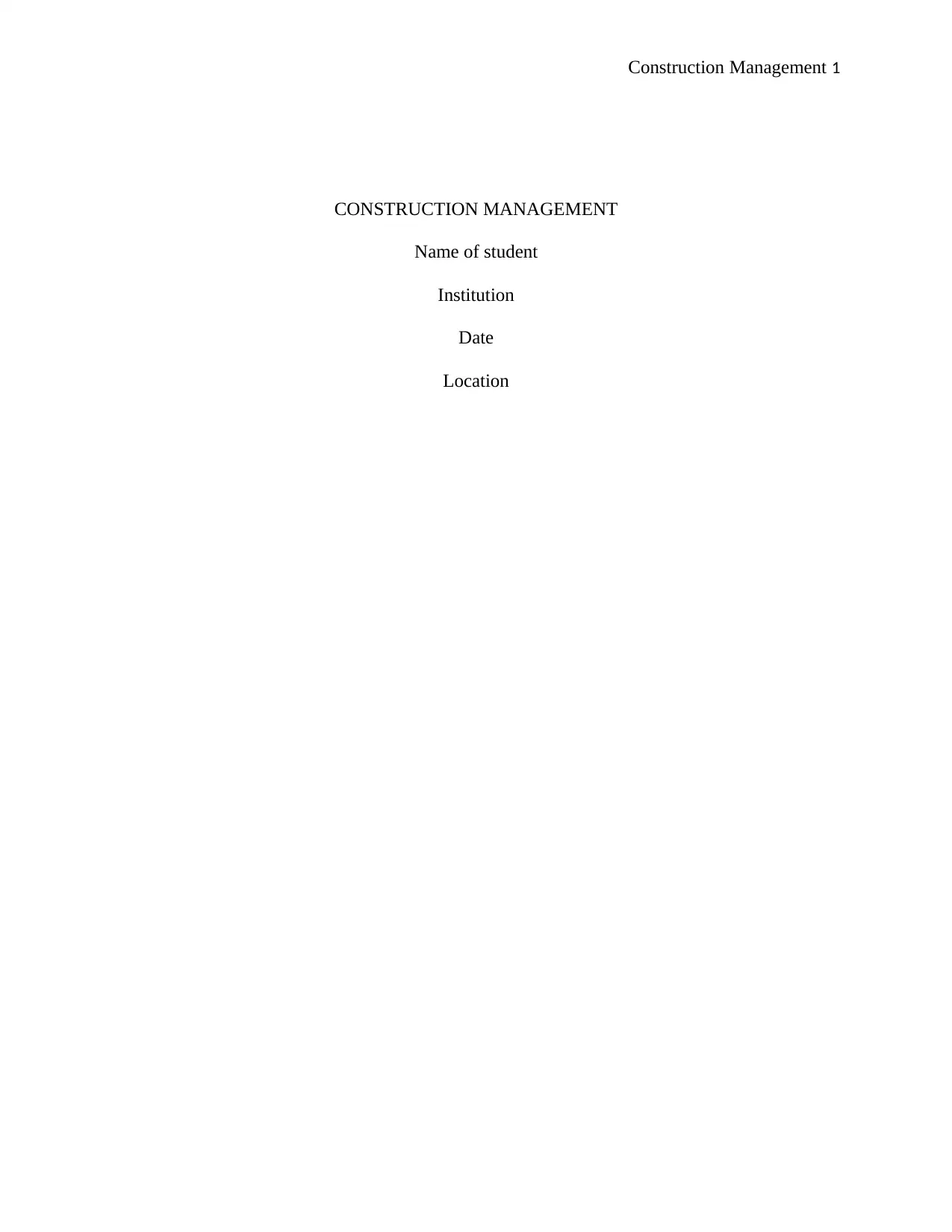
Construction Management 1
CONSTRUCTION MANAGEMENT
Name of student
Institution
Date
Location
CONSTRUCTION MANAGEMENT
Name of student
Institution
Date
Location
Paraphrase This Document
Need a fresh take? Get an instant paraphrase of this document with our AI Paraphraser
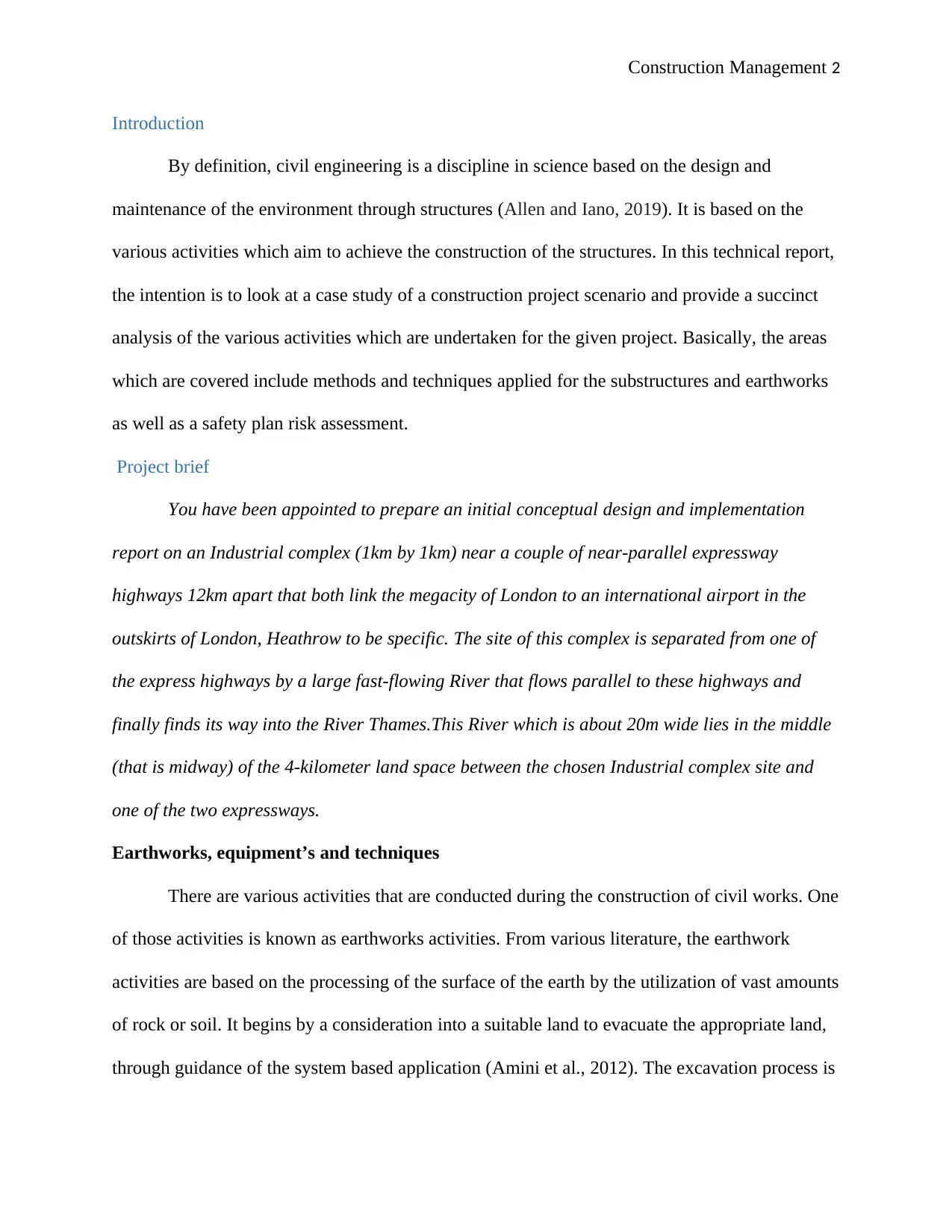
Construction Management 2
Introduction
By definition, civil engineering is a discipline in science based on the design and
maintenance of the environment through structures (Allen and Iano, 2019). It is based on the
various activities which aim to achieve the construction of the structures. In this technical report,
the intention is to look at a case study of a construction project scenario and provide a succinct
analysis of the various activities which are undertaken for the given project. Basically, the areas
which are covered include methods and techniques applied for the substructures and earthworks
as well as a safety plan risk assessment.
Project brief
You have been appointed to prepare an initial conceptual design and implementation
report on an Industrial complex (1km by 1km) near a couple of near-parallel expressway
highways 12km apart that both link the megacity of London to an international airport in the
outskirts of London, Heathrow to be specific. The site of this complex is separated from one of
the express highways by a large fast-flowing River that flows parallel to these highways and
finally finds its way into the River Thames.This River which is about 20m wide lies in the middle
(that is midway) of the 4-kilometer land space between the chosen Industrial complex site and
one of the two expressways.
Earthworks, equipment’s and techniques
There are various activities that are conducted during the construction of civil works. One
of those activities is known as earthworks activities. From various literature, the earthwork
activities are based on the processing of the surface of the earth by the utilization of vast amounts
of rock or soil. It begins by a consideration into a suitable land to evacuate the appropriate land,
through guidance of the system based application (Amini et al., 2012). The excavation process is
Introduction
By definition, civil engineering is a discipline in science based on the design and
maintenance of the environment through structures (Allen and Iano, 2019). It is based on the
various activities which aim to achieve the construction of the structures. In this technical report,
the intention is to look at a case study of a construction project scenario and provide a succinct
analysis of the various activities which are undertaken for the given project. Basically, the areas
which are covered include methods and techniques applied for the substructures and earthworks
as well as a safety plan risk assessment.
Project brief
You have been appointed to prepare an initial conceptual design and implementation
report on an Industrial complex (1km by 1km) near a couple of near-parallel expressway
highways 12km apart that both link the megacity of London to an international airport in the
outskirts of London, Heathrow to be specific. The site of this complex is separated from one of
the express highways by a large fast-flowing River that flows parallel to these highways and
finally finds its way into the River Thames.This River which is about 20m wide lies in the middle
(that is midway) of the 4-kilometer land space between the chosen Industrial complex site and
one of the two expressways.
Earthworks, equipment’s and techniques
There are various activities that are conducted during the construction of civil works. One
of those activities is known as earthworks activities. From various literature, the earthwork
activities are based on the processing of the surface of the earth by the utilization of vast amounts
of rock or soil. It begins by a consideration into a suitable land to evacuate the appropriate land,
through guidance of the system based application (Amini et al., 2012). The excavation process is
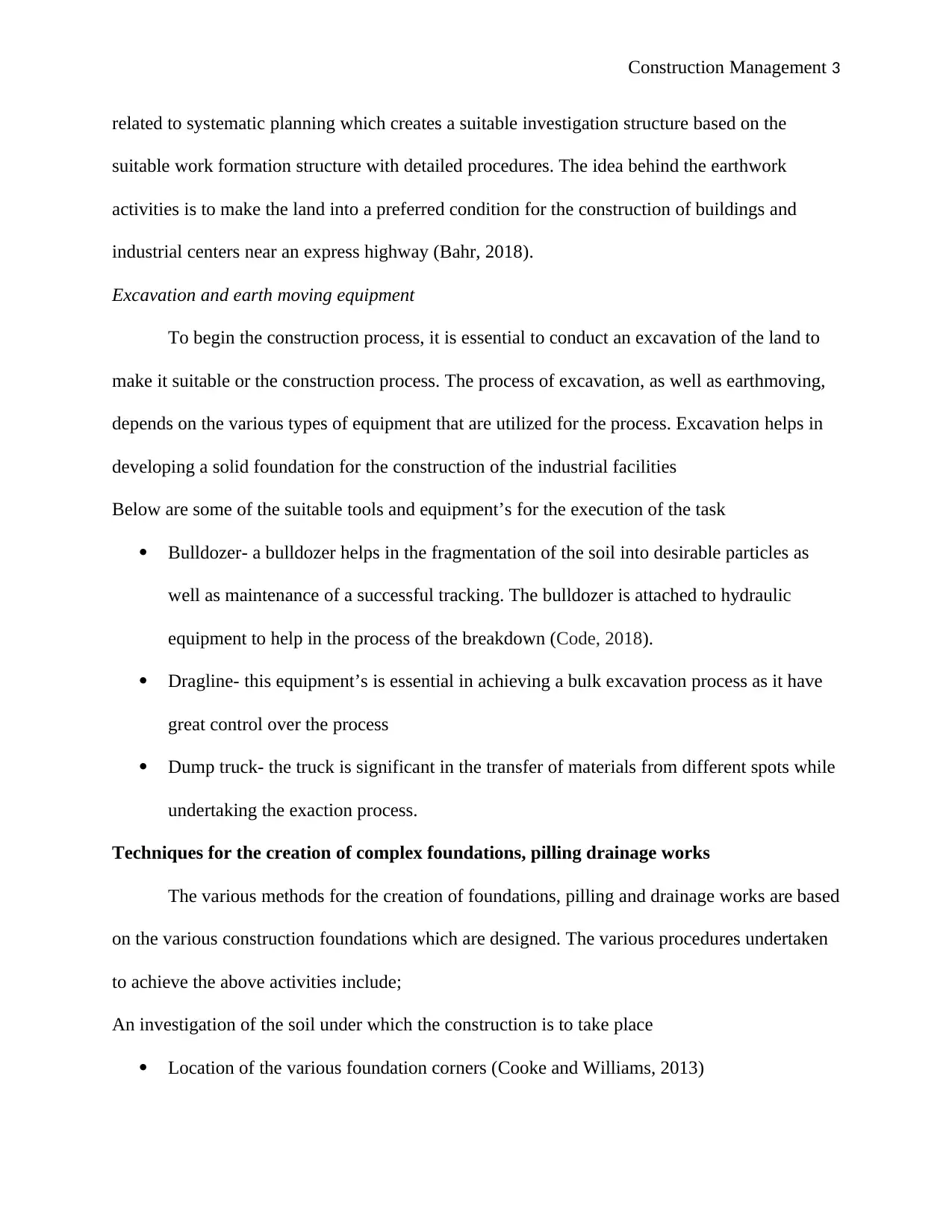
Construction Management 3
related to systematic planning which creates a suitable investigation structure based on the
suitable work formation structure with detailed procedures. The idea behind the earthwork
activities is to make the land into a preferred condition for the construction of buildings and
industrial centers near an express highway (Bahr, 2018).
Excavation and earth moving equipment
To begin the construction process, it is essential to conduct an excavation of the land to
make it suitable or the construction process. The process of excavation, as well as earthmoving,
depends on the various types of equipment that are utilized for the process. Excavation helps in
developing a solid foundation for the construction of the industrial facilities
Below are some of the suitable tools and equipment’s for the execution of the task
Bulldozer- a bulldozer helps in the fragmentation of the soil into desirable particles as
well as maintenance of a successful tracking. The bulldozer is attached to hydraulic
equipment to help in the process of the breakdown (Code, 2018).
Dragline- this equipment’s is essential in achieving a bulk excavation process as it have
great control over the process
Dump truck- the truck is significant in the transfer of materials from different spots while
undertaking the exaction process.
Techniques for the creation of complex foundations, pilling drainage works
The various methods for the creation of foundations, pilling and drainage works are based
on the various construction foundations which are designed. The various procedures undertaken
to achieve the above activities include;
An investigation of the soil under which the construction is to take place
Location of the various foundation corners (Cooke and Williams, 2013)
related to systematic planning which creates a suitable investigation structure based on the
suitable work formation structure with detailed procedures. The idea behind the earthwork
activities is to make the land into a preferred condition for the construction of buildings and
industrial centers near an express highway (Bahr, 2018).
Excavation and earth moving equipment
To begin the construction process, it is essential to conduct an excavation of the land to
make it suitable or the construction process. The process of excavation, as well as earthmoving,
depends on the various types of equipment that are utilized for the process. Excavation helps in
developing a solid foundation for the construction of the industrial facilities
Below are some of the suitable tools and equipment’s for the execution of the task
Bulldozer- a bulldozer helps in the fragmentation of the soil into desirable particles as
well as maintenance of a successful tracking. The bulldozer is attached to hydraulic
equipment to help in the process of the breakdown (Code, 2018).
Dragline- this equipment’s is essential in achieving a bulk excavation process as it have
great control over the process
Dump truck- the truck is significant in the transfer of materials from different spots while
undertaking the exaction process.
Techniques for the creation of complex foundations, pilling drainage works
The various methods for the creation of foundations, pilling and drainage works are based
on the various construction foundations which are designed. The various procedures undertaken
to achieve the above activities include;
An investigation of the soil under which the construction is to take place
Location of the various foundation corners (Cooke and Williams, 2013)
⊘ This is a preview!⊘
Do you want full access?
Subscribe today to unlock all pages.

Trusted by 1+ million students worldwide

Construction Management 4
Installation of footing
Sealing of the footing to eradicate moisture
Poring of concrete mixture
Sealing to help in the treatment of the foundation
Shallow foundations
These are foundations that do not go deep into the soil. They are available on the first
strata hard soil. They are of different types namely; grillage foundations, steeped foundations,
spread footing foundations, raft foundations, and inverted arch foundations. Since the foundation
of the industrial facilities is to be mostly made of steel and RCC, the most suitable foundation is
the steel grillage foundation (Couldry and Hepp, 2018).
Method
I. Excavation of trench 1.50 m deep, after which ramming and leveling done
II. This is followed by a cement concrete being laid about 30 cm thick and then compacted
III. The layers of steel are then laid with beams designed at distances apart.
IV. Another concrete layer is added and then finally the entire region is covered with
concrete.
Techniques for culvert, underpass construction and provision of utilities
There are a number of techniques for achieving the construction of underpass and culvert
as well as the provision of facilities. These methods vary according to the tools and equipment
which are applied in the construction. For the construction of culvert; a half culvert will first be
construction which begins y the process of excavation (Darus, 2014). Based on the original
drawing by the engineer, the bed of the culvert shall be prepared at various levels. This will be
Installation of footing
Sealing of the footing to eradicate moisture
Poring of concrete mixture
Sealing to help in the treatment of the foundation
Shallow foundations
These are foundations that do not go deep into the soil. They are available on the first
strata hard soil. They are of different types namely; grillage foundations, steeped foundations,
spread footing foundations, raft foundations, and inverted arch foundations. Since the foundation
of the industrial facilities is to be mostly made of steel and RCC, the most suitable foundation is
the steel grillage foundation (Couldry and Hepp, 2018).
Method
I. Excavation of trench 1.50 m deep, after which ramming and leveling done
II. This is followed by a cement concrete being laid about 30 cm thick and then compacted
III. The layers of steel are then laid with beams designed at distances apart.
IV. Another concrete layer is added and then finally the entire region is covered with
concrete.
Techniques for culvert, underpass construction and provision of utilities
There are a number of techniques for achieving the construction of underpass and culvert
as well as the provision of facilities. These methods vary according to the tools and equipment
which are applied in the construction. For the construction of culvert; a half culvert will first be
construction which begins y the process of excavation (Darus, 2014). Based on the original
drawing by the engineer, the bed of the culvert shall be prepared at various levels. This will be
Paraphrase This Document
Need a fresh take? Get an instant paraphrase of this document with our AI Paraphraser
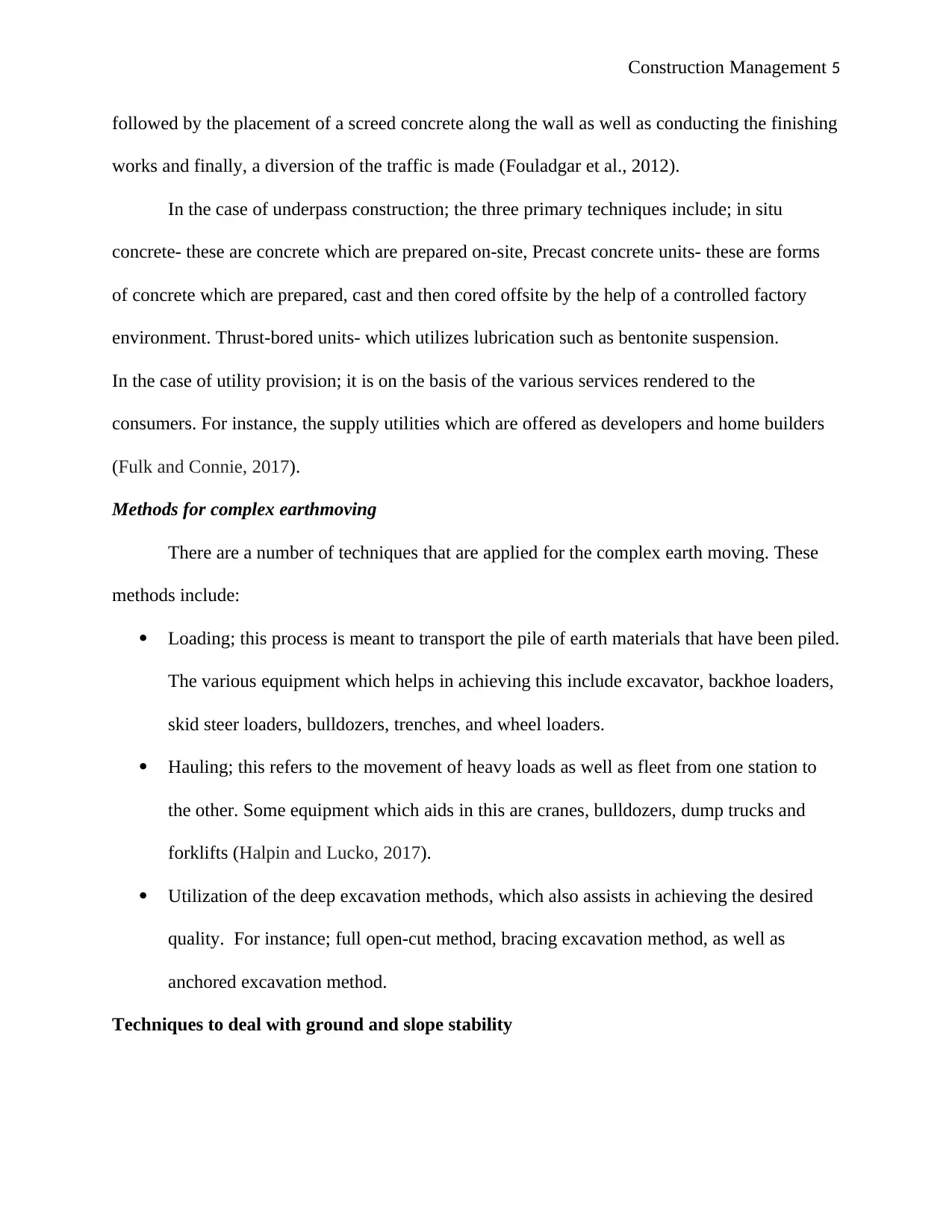
Construction Management 5
followed by the placement of a screed concrete along the wall as well as conducting the finishing
works and finally, a diversion of the traffic is made (Fouladgar et al., 2012).
In the case of underpass construction; the three primary techniques include; in situ
concrete- these are concrete which are prepared on-site, Precast concrete units- these are forms
of concrete which are prepared, cast and then cored offsite by the help of a controlled factory
environment. Thrust-bored units- which utilizes lubrication such as bentonite suspension.
In the case of utility provision; it is on the basis of the various services rendered to the
consumers. For instance, the supply utilities which are offered as developers and home builders
(Fulk and Connie, 2017).
Methods for complex earthmoving
There are a number of techniques that are applied for the complex earth moving. These
methods include:
Loading; this process is meant to transport the pile of earth materials that have been piled.
The various equipment which helps in achieving this include excavator, backhoe loaders,
skid steer loaders, bulldozers, trenches, and wheel loaders.
Hauling; this refers to the movement of heavy loads as well as fleet from one station to
the other. Some equipment which aids in this are cranes, bulldozers, dump trucks and
forklifts (Halpin and Lucko, 2017).
Utilization of the deep excavation methods, which also assists in achieving the desired
quality. For instance; full open-cut method, bracing excavation method, as well as
anchored excavation method.
Techniques to deal with ground and slope stability
followed by the placement of a screed concrete along the wall as well as conducting the finishing
works and finally, a diversion of the traffic is made (Fouladgar et al., 2012).
In the case of underpass construction; the three primary techniques include; in situ
concrete- these are concrete which are prepared on-site, Precast concrete units- these are forms
of concrete which are prepared, cast and then cored offsite by the help of a controlled factory
environment. Thrust-bored units- which utilizes lubrication such as bentonite suspension.
In the case of utility provision; it is on the basis of the various services rendered to the
consumers. For instance, the supply utilities which are offered as developers and home builders
(Fulk and Connie, 2017).
Methods for complex earthmoving
There are a number of techniques that are applied for the complex earth moving. These
methods include:
Loading; this process is meant to transport the pile of earth materials that have been piled.
The various equipment which helps in achieving this include excavator, backhoe loaders,
skid steer loaders, bulldozers, trenches, and wheel loaders.
Hauling; this refers to the movement of heavy loads as well as fleet from one station to
the other. Some equipment which aids in this are cranes, bulldozers, dump trucks and
forklifts (Halpin and Lucko, 2017).
Utilization of the deep excavation methods, which also assists in achieving the desired
quality. For instance; full open-cut method, bracing excavation method, as well as
anchored excavation method.
Techniques to deal with ground and slope stability
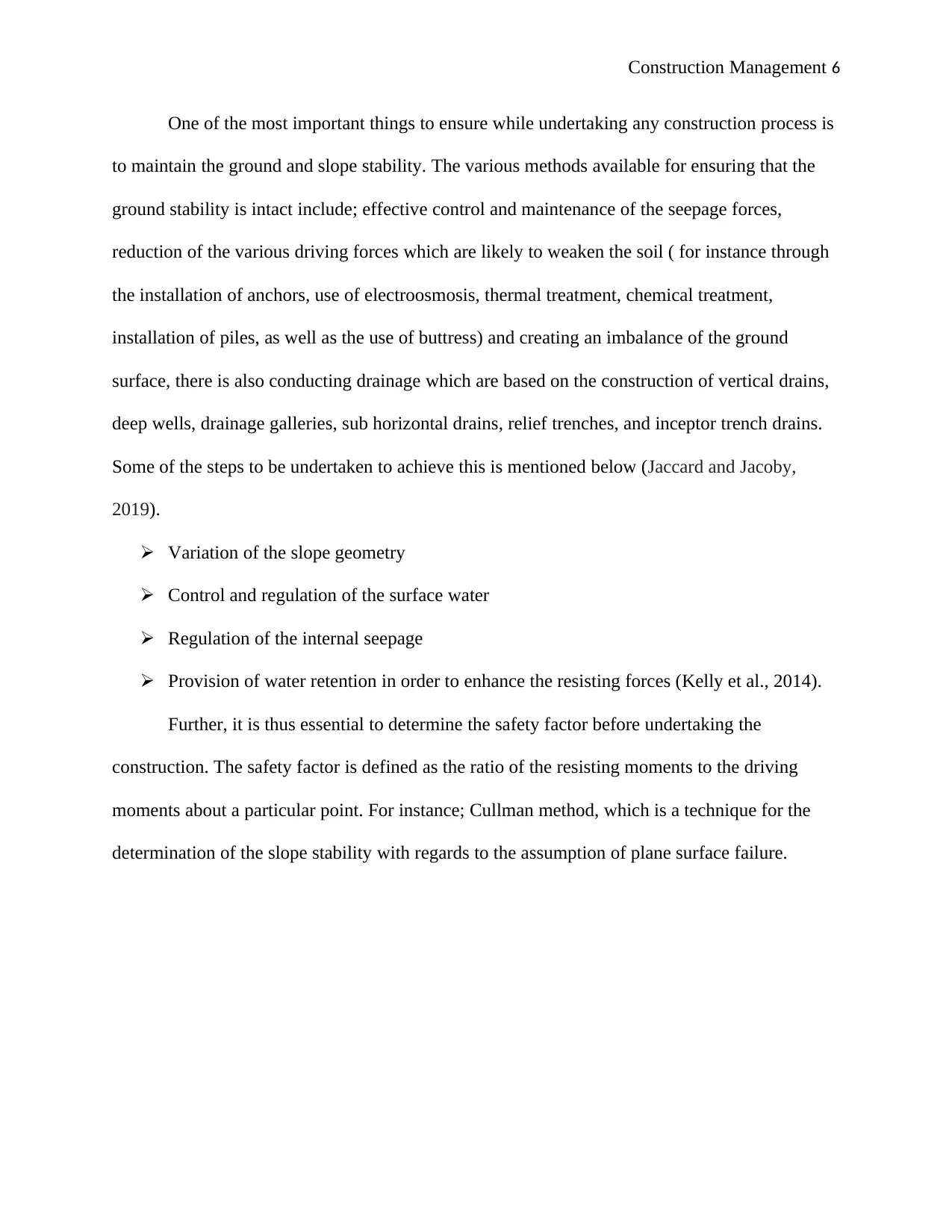
Construction Management 6
One of the most important things to ensure while undertaking any construction process is
to maintain the ground and slope stability. The various methods available for ensuring that the
ground stability is intact include; effective control and maintenance of the seepage forces,
reduction of the various driving forces which are likely to weaken the soil ( for instance through
the installation of anchors, use of electroosmosis, thermal treatment, chemical treatment,
installation of piles, as well as the use of buttress) and creating an imbalance of the ground
surface, there is also conducting drainage which are based on the construction of vertical drains,
deep wells, drainage galleries, sub horizontal drains, relief trenches, and inceptor trench drains.
Some of the steps to be undertaken to achieve this is mentioned below (Jaccard and Jacoby,
2019).
Variation of the slope geometry
Control and regulation of the surface water
Regulation of the internal seepage
Provision of water retention in order to enhance the resisting forces (Kelly et al., 2014).
Further, it is thus essential to determine the safety factor before undertaking the
construction. The safety factor is defined as the ratio of the resisting moments to the driving
moments about a particular point. For instance; Cullman method, which is a technique for the
determination of the slope stability with regards to the assumption of plane surface failure.
One of the most important things to ensure while undertaking any construction process is
to maintain the ground and slope stability. The various methods available for ensuring that the
ground stability is intact include; effective control and maintenance of the seepage forces,
reduction of the various driving forces which are likely to weaken the soil ( for instance through
the installation of anchors, use of electroosmosis, thermal treatment, chemical treatment,
installation of piles, as well as the use of buttress) and creating an imbalance of the ground
surface, there is also conducting drainage which are based on the construction of vertical drains,
deep wells, drainage galleries, sub horizontal drains, relief trenches, and inceptor trench drains.
Some of the steps to be undertaken to achieve this is mentioned below (Jaccard and Jacoby,
2019).
Variation of the slope geometry
Control and regulation of the surface water
Regulation of the internal seepage
Provision of water retention in order to enhance the resisting forces (Kelly et al., 2014).
Further, it is thus essential to determine the safety factor before undertaking the
construction. The safety factor is defined as the ratio of the resisting moments to the driving
moments about a particular point. For instance; Cullman method, which is a technique for the
determination of the slope stability with regards to the assumption of plane surface failure.
⊘ This is a preview!⊘
Do you want full access?
Subscribe today to unlock all pages.

Trusted by 1+ million students worldwide

Construction Management 7
Lo2: Manage a project within agreed timescales and specification,
documenting the process throughout
It has been established that there are various risks and hazards which are associated with
the construction of various facilities. For the construction of this industrial part, a number of
activities will be involved, and it's the particular activities which promote the hazards and risk.
Some of the available risks and hazards include; falls from working height, breakdown of weak
surfaces, falling objects from, accidents from moving objects such as cranes and bulldozers
(Keshavarz et al., 2015).
Hazards and risks
Risk hazard Safety arrangement
Working at
heights
The grounds might be slippery hence
resulting in falls. Also, misuse of
equipment or human error can result
in falls
Implementing safety procedures, use
of the appropriate PPE, installation of
guard rails as well as the use of the
correct equipment.
Collapse Collapse occurs at any stage, more so
during excavation as well as
uncovered surfaces which might lead
to grave injuries or death
Implementation of protective systems
such as guard rails, as well as use of
appropriate PPE (Kibert, 2016).
Moving
vehicles and
objects
These are likely to results in accidents
and nocks from the moving objects
that are likely to lead to death or
injuries
Barricading some of the delicate
zones, as well as incorporation of
various safety plant features
Electricity Open wires are likely to cause
electrocution when exposed carelessly
Handling of electrical activities by
qualified technicians, use of electrical
Lo2: Manage a project within agreed timescales and specification,
documenting the process throughout
It has been established that there are various risks and hazards which are associated with
the construction of various facilities. For the construction of this industrial part, a number of
activities will be involved, and it's the particular activities which promote the hazards and risk.
Some of the available risks and hazards include; falls from working height, breakdown of weak
surfaces, falling objects from, accidents from moving objects such as cranes and bulldozers
(Keshavarz et al., 2015).
Hazards and risks
Risk hazard Safety arrangement
Working at
heights
The grounds might be slippery hence
resulting in falls. Also, misuse of
equipment or human error can result
in falls
Implementing safety procedures, use
of the appropriate PPE, installation of
guard rails as well as the use of the
correct equipment.
Collapse Collapse occurs at any stage, more so
during excavation as well as
uncovered surfaces which might lead
to grave injuries or death
Implementation of protective systems
such as guard rails, as well as use of
appropriate PPE (Kibert, 2016).
Moving
vehicles and
objects
These are likely to results in accidents
and nocks from the moving objects
that are likely to lead to death or
injuries
Barricading some of the delicate
zones, as well as incorporation of
various safety plant features
Electricity Open wires are likely to cause
electrocution when exposed carelessly
Handling of electrical activities by
qualified technicians, use of electrical
Paraphrase This Document
Need a fresh take? Get an instant paraphrase of this document with our AI Paraphraser

Construction Management 8
or handle by unqualified staff. safety signs, also ensuring that the
electrical connections are done
appropriately and any open-wire be
covered (Levin, 2016).
Manual
handling
Most of the activities involve the
handling of a system by manual
hands, which are likely to cause injury
when not properly handled (Li et al.,
2014).
To eliminate such risks it is required to
undertake a risk assessment as well as
the introduction of various required
protocols to be adhered to while
handling the equipment’s manually
Also, correct use of PPE should be
encouraged.
Harmful
materials
Harmful materials such as paints,
asbestos, as well as other solvents
pose great respiratory problems to the
users
Use of the correct PPE while handling
such materials helps in reducing their
level of harm, as well as strict
adherence to the established protocols
while handling the materials (McLeod
and Chaffee, 2017).
Noise There is a lot of noise that emanates
from the excavation process as well as
other activities within the industrial
park construction facility which
potentially can result in hearing
impairment (Monahan and Powell,
Use of the correct PPE while handling
such materials helps in reducing their
level of harm, as well as strict
adherence to the established protocols
while handling the materials.
or handle by unqualified staff. safety signs, also ensuring that the
electrical connections are done
appropriately and any open-wire be
covered (Levin, 2016).
Manual
handling
Most of the activities involve the
handling of a system by manual
hands, which are likely to cause injury
when not properly handled (Li et al.,
2014).
To eliminate such risks it is required to
undertake a risk assessment as well as
the introduction of various required
protocols to be adhered to while
handling the equipment’s manually
Also, correct use of PPE should be
encouraged.
Harmful
materials
Harmful materials such as paints,
asbestos, as well as other solvents
pose great respiratory problems to the
users
Use of the correct PPE while handling
such materials helps in reducing their
level of harm, as well as strict
adherence to the established protocols
while handling the materials (McLeod
and Chaffee, 2017).
Noise There is a lot of noise that emanates
from the excavation process as well as
other activities within the industrial
park construction facility which
potentially can result in hearing
impairment (Monahan and Powell,
Use of the correct PPE while handling
such materials helps in reducing their
level of harm, as well as strict
adherence to the established protocols
while handling the materials.

Construction Management 9
2011).
2011).
⊘ This is a preview!⊘
Do you want full access?
Subscribe today to unlock all pages.

Trusted by 1+ million students worldwide
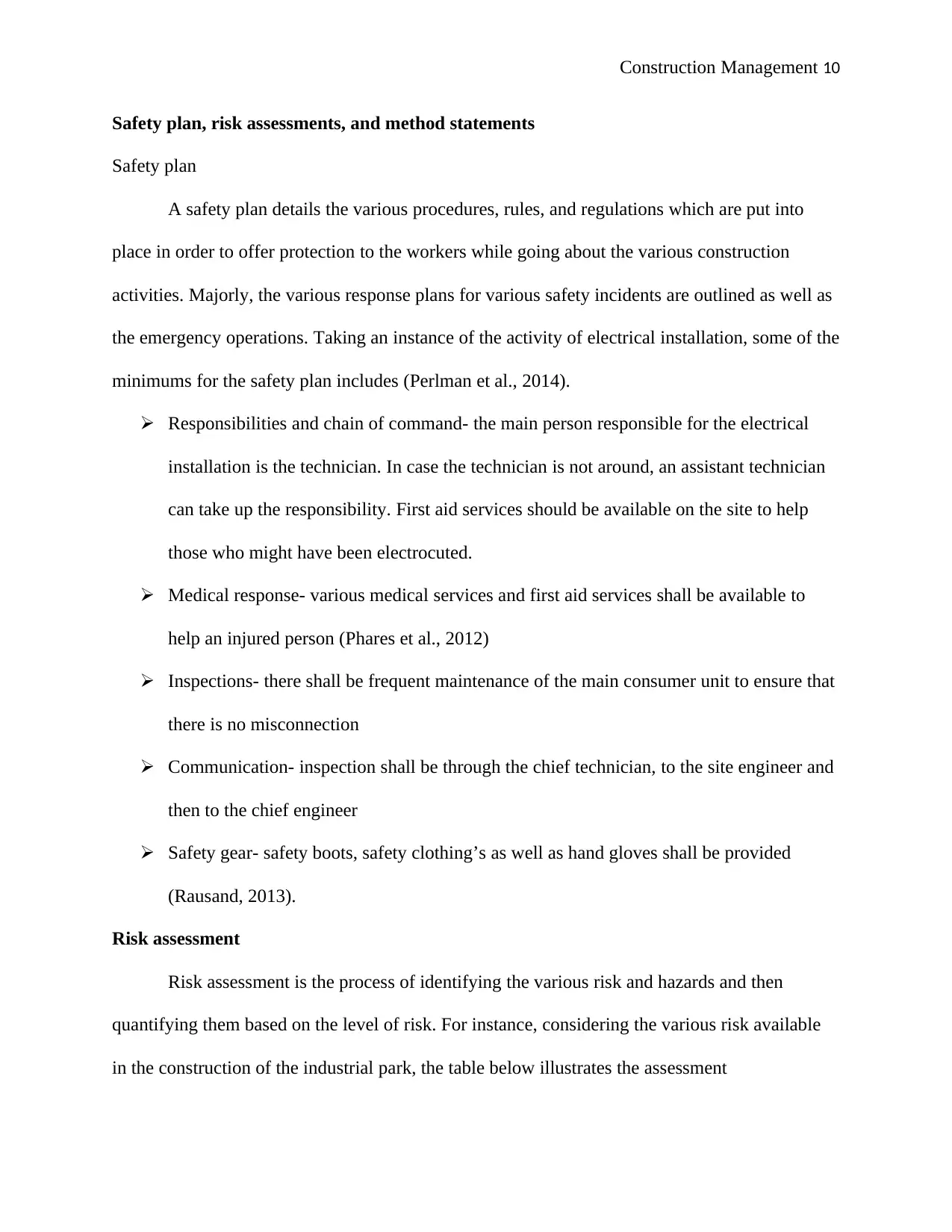
Construction Management 10
Safety plan, risk assessments, and method statements
Safety plan
A safety plan details the various procedures, rules, and regulations which are put into
place in order to offer protection to the workers while going about the various construction
activities. Majorly, the various response plans for various safety incidents are outlined as well as
the emergency operations. Taking an instance of the activity of electrical installation, some of the
minimums for the safety plan includes (Perlman et al., 2014).
Responsibilities and chain of command- the main person responsible for the electrical
installation is the technician. In case the technician is not around, an assistant technician
can take up the responsibility. First aid services should be available on the site to help
those who might have been electrocuted.
Medical response- various medical services and first aid services shall be available to
help an injured person (Phares et al., 2012)
Inspections- there shall be frequent maintenance of the main consumer unit to ensure that
there is no misconnection
Communication- inspection shall be through the chief technician, to the site engineer and
then to the chief engineer
Safety gear- safety boots, safety clothing’s as well as hand gloves shall be provided
(Rausand, 2013).
Risk assessment
Risk assessment is the process of identifying the various risk and hazards and then
quantifying them based on the level of risk. For instance, considering the various risk available
in the construction of the industrial park, the table below illustrates the assessment
Safety plan, risk assessments, and method statements
Safety plan
A safety plan details the various procedures, rules, and regulations which are put into
place in order to offer protection to the workers while going about the various construction
activities. Majorly, the various response plans for various safety incidents are outlined as well as
the emergency operations. Taking an instance of the activity of electrical installation, some of the
minimums for the safety plan includes (Perlman et al., 2014).
Responsibilities and chain of command- the main person responsible for the electrical
installation is the technician. In case the technician is not around, an assistant technician
can take up the responsibility. First aid services should be available on the site to help
those who might have been electrocuted.
Medical response- various medical services and first aid services shall be available to
help an injured person (Phares et al., 2012)
Inspections- there shall be frequent maintenance of the main consumer unit to ensure that
there is no misconnection
Communication- inspection shall be through the chief technician, to the site engineer and
then to the chief engineer
Safety gear- safety boots, safety clothing’s as well as hand gloves shall be provided
(Rausand, 2013).
Risk assessment
Risk assessment is the process of identifying the various risk and hazards and then
quantifying them based on the level of risk. For instance, considering the various risk available
in the construction of the industrial park, the table below illustrates the assessment
Paraphrase This Document
Need a fresh take? Get an instant paraphrase of this document with our AI Paraphraser
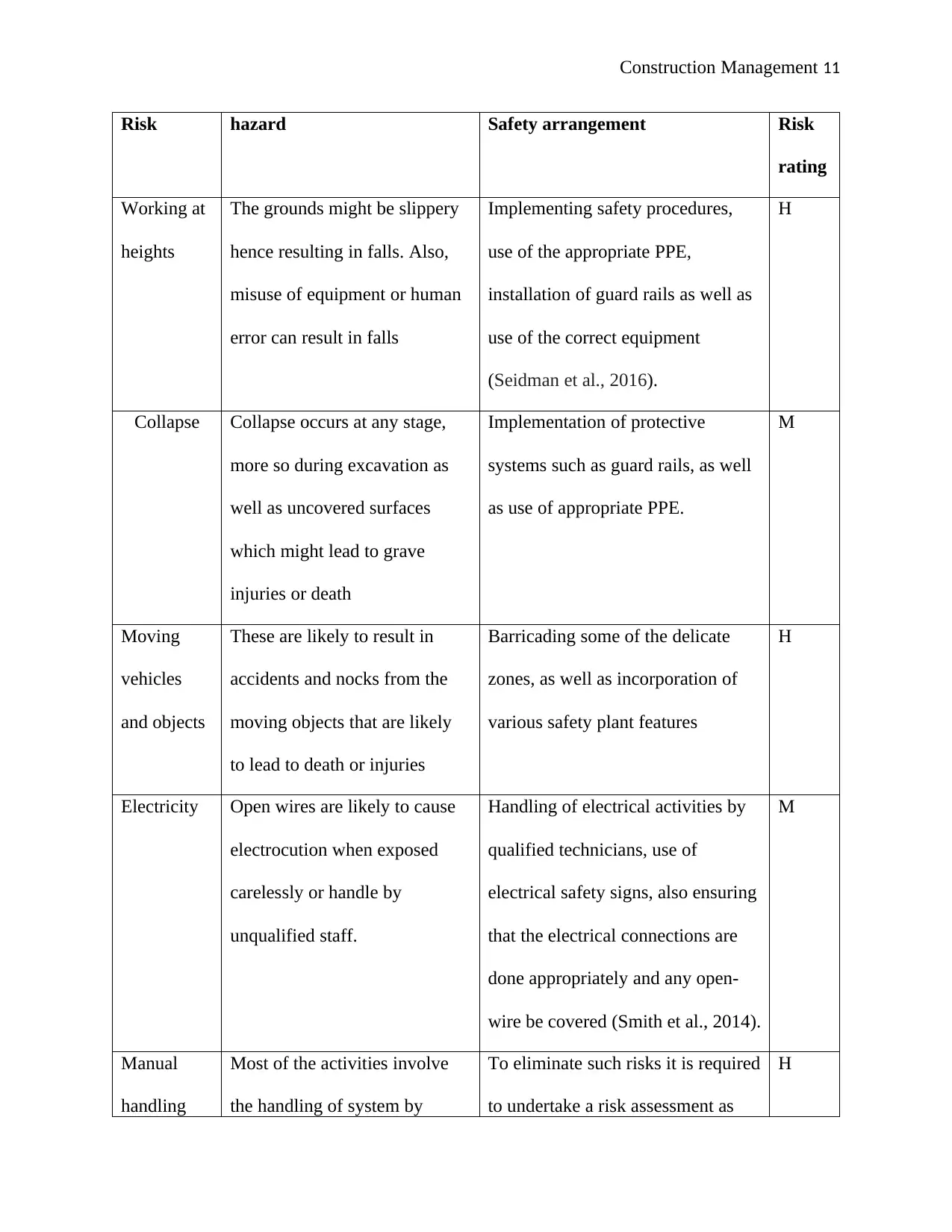
Construction Management 11
Risk hazard Safety arrangement Risk
rating
Working at
heights
The grounds might be slippery
hence resulting in falls. Also,
misuse of equipment or human
error can result in falls
Implementing safety procedures,
use of the appropriate PPE,
installation of guard rails as well as
use of the correct equipment
(Seidman et al., 2016).
H
Collapse Collapse occurs at any stage,
more so during excavation as
well as uncovered surfaces
which might lead to grave
injuries or death
Implementation of protective
systems such as guard rails, as well
as use of appropriate PPE.
M
Moving
vehicles
and objects
These are likely to result in
accidents and nocks from the
moving objects that are likely
to lead to death or injuries
Barricading some of the delicate
zones, as well as incorporation of
various safety plant features
H
Electricity Open wires are likely to cause
electrocution when exposed
carelessly or handle by
unqualified staff.
Handling of electrical activities by
qualified technicians, use of
electrical safety signs, also ensuring
that the electrical connections are
done appropriately and any open-
wire be covered (Smith et al., 2014).
M
Manual
handling
Most of the activities involve
the handling of system by
To eliminate such risks it is required
to undertake a risk assessment as
H
Risk hazard Safety arrangement Risk
rating
Working at
heights
The grounds might be slippery
hence resulting in falls. Also,
misuse of equipment or human
error can result in falls
Implementing safety procedures,
use of the appropriate PPE,
installation of guard rails as well as
use of the correct equipment
(Seidman et al., 2016).
H
Collapse Collapse occurs at any stage,
more so during excavation as
well as uncovered surfaces
which might lead to grave
injuries or death
Implementation of protective
systems such as guard rails, as well
as use of appropriate PPE.
M
Moving
vehicles
and objects
These are likely to result in
accidents and nocks from the
moving objects that are likely
to lead to death or injuries
Barricading some of the delicate
zones, as well as incorporation of
various safety plant features
H
Electricity Open wires are likely to cause
electrocution when exposed
carelessly or handle by
unqualified staff.
Handling of electrical activities by
qualified technicians, use of
electrical safety signs, also ensuring
that the electrical connections are
done appropriately and any open-
wire be covered (Smith et al., 2014).
M
Manual
handling
Most of the activities involve
the handling of system by
To eliminate such risks it is required
to undertake a risk assessment as
H
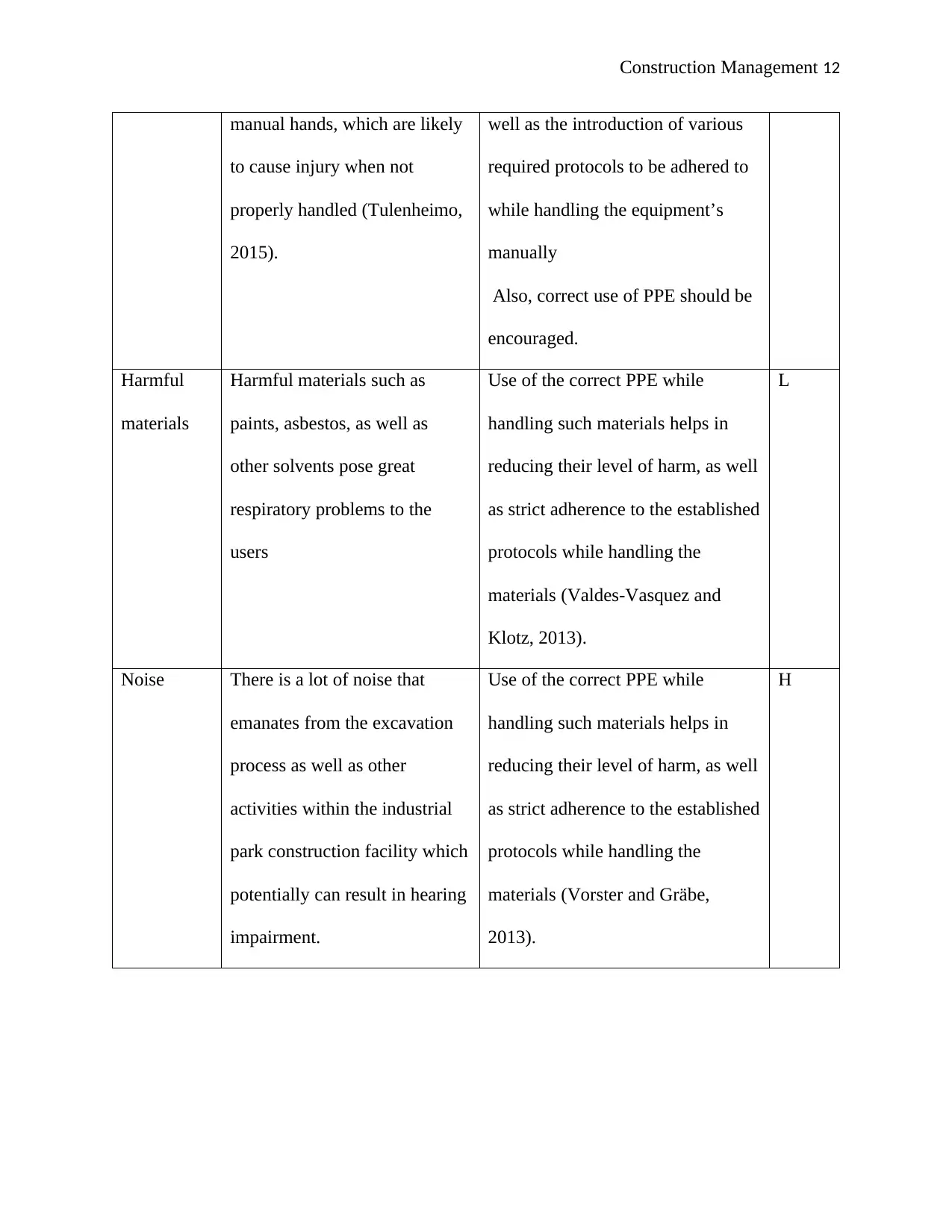
Construction Management 12
manual hands, which are likely
to cause injury when not
properly handled (Tulenheimo,
2015).
well as the introduction of various
required protocols to be adhered to
while handling the equipment’s
manually
Also, correct use of PPE should be
encouraged.
Harmful
materials
Harmful materials such as
paints, asbestos, as well as
other solvents pose great
respiratory problems to the
users
Use of the correct PPE while
handling such materials helps in
reducing their level of harm, as well
as strict adherence to the established
protocols while handling the
materials (Valdes-Vasquez and
Klotz, 2013).
L
Noise There is a lot of noise that
emanates from the excavation
process as well as other
activities within the industrial
park construction facility which
potentially can result in hearing
impairment.
Use of the correct PPE while
handling such materials helps in
reducing their level of harm, as well
as strict adherence to the established
protocols while handling the
materials (Vorster and Gräbe,
2013).
H
manual hands, which are likely
to cause injury when not
properly handled (Tulenheimo,
2015).
well as the introduction of various
required protocols to be adhered to
while handling the equipment’s
manually
Also, correct use of PPE should be
encouraged.
Harmful
materials
Harmful materials such as
paints, asbestos, as well as
other solvents pose great
respiratory problems to the
users
Use of the correct PPE while
handling such materials helps in
reducing their level of harm, as well
as strict adherence to the established
protocols while handling the
materials (Valdes-Vasquez and
Klotz, 2013).
L
Noise There is a lot of noise that
emanates from the excavation
process as well as other
activities within the industrial
park construction facility which
potentially can result in hearing
impairment.
Use of the correct PPE while
handling such materials helps in
reducing their level of harm, as well
as strict adherence to the established
protocols while handling the
materials (Vorster and Gräbe,
2013).
H
⊘ This is a preview!⊘
Do you want full access?
Subscribe today to unlock all pages.

Trusted by 1+ million students worldwide
1 out of 25
Related Documents
Your All-in-One AI-Powered Toolkit for Academic Success.
+13062052269
info@desklib.com
Available 24*7 on WhatsApp / Email
![[object Object]](/_next/static/media/star-bottom.7253800d.svg)
Unlock your academic potential
Copyright © 2020–2025 A2Z Services. All Rights Reserved. Developed and managed by ZUCOL.


